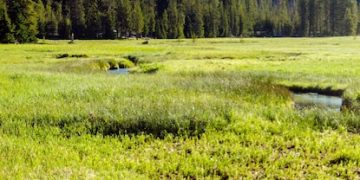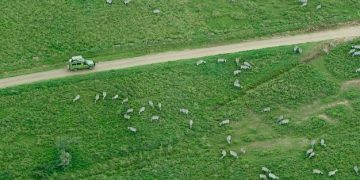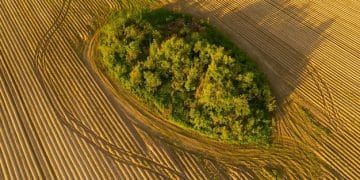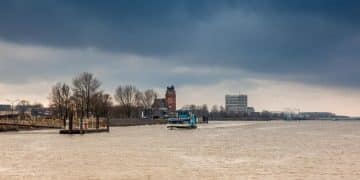Deforestation Impacts: US Ecosystems & Biodiversity at Risk
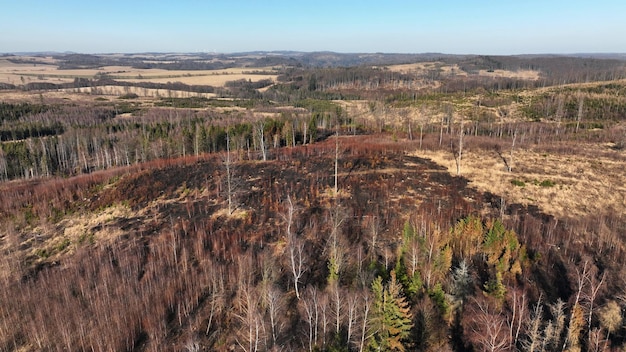
Deforestation in the U.S. may lead to habitat loss, reduced biodiversity, increased soil erosion, altered climate patterns, and decreased water quality, thereby impacting various ecosystems and species.
What are the potential impacts of
What are the potential impacts of deforestation on US ecosystems and biodiversity? As forests disappear across the United States, understanding the consequences becomes crucial. The destruction of these vital habitats poses a significant threat to the delicate balance of nature, impacting everything from the smallest insects to the largest mammals. Let’s explore the far-reaching effects of deforestation and what it means for the future of America’s natural heritage.
Deforestation and Habitat Loss in the US
Deforestation leads to habitat loss, which is one of the most immediate and devastating impacts on US ecosystems. Habitats are the natural environments where plants and animals live. When forests are cleared, these habitats are destroyed, leaving countless species without a place to live.
The Direct Impact on Wildlife
Many animals rely on forests for food, shelter, and breeding grounds. When these forests disappear, so do the resources these animals need to survive. This can lead to a decline in population sizes, and in some cases, extinction.
Fragmented Habitats and Isolation
Deforestation often results in fragmented habitats, where small patches of forest are isolated from one another. This isolation can prevent animals from moving freely between habitats, making it difficult for them to find food, mates, or suitable living conditions.
- Loss of nesting sites for migratory birds
- Disruption of migration routes for mammals
- Increased competition among remaining species

In conclusion, deforestation-induced habitat loss can devastate wildlife, fragment ecosystems, and disrupt ecological processes. Protecting and restoring forest habitats is crucial for preserving the biodiversity and ecological integrity of the US.
Biodiversity Loss Due to Deforestation
Deforestation significantly contributes to biodiversity loss in the United States. Forests are home to a vast array of plant and animal species, and their destruction can lead to a rapid decline in the number of different species in an ecosystem.
Endangered and Threatened Species
Many species unique to US forests are already endangered or threatened. Deforestation exacerbates their plight by removing their last remaining habitats. This can push these species closer to extinction.
The Role of Forests in Species Richness
Forests provide a range of ecological niches that support a diverse community of organisms. Trees, shrubs, and groundcover plants all offer different habitats and resources for animals. When forests are cleared, these niches disappear, reducing the overall species richness of an area.
Deforestation can also disrupt ecological interactions. For example, the loss of pollinators like bees and butterflies can affect the reproduction of many plant species, leading to further declines in biodiversity.
In summary, deforestation significantly diminishes biodiversity by destroying habitats, endangering species, and disrupting ecological interactions. Conservation efforts are essential for protecting the rich variety of life in US forests.
Soil Erosion and Water Quality Impacts
The potential impacts of deforestation on US ecosystems and biodiversity extend to soil erosion and water quality. Forests play a vital role in maintaining soil stability and regulating water flow. When trees are removed, the soil becomes vulnerable to erosion, and water quality declines.
How Deforestation Leads to Soil Erosion
Tree roots hold the soil in place, preventing it from being washed away by rain or blown away by wind. When forests are cleared, the soil is exposed, making it more susceptible to erosion. This erosion can lead to the loss of valuable topsoil, which is essential for plant growth.
The Impact on Water Quality
Deforestation can also degrade water quality. When soil erodes, it carries sediment into rivers and streams, clouding the water and harming aquatic life. Excess sediment can smother fish eggs, clog the gills of fish, and reduce the amount of sunlight available to aquatic plants.
The Role of Forests in Water Regulation
Forests act as natural sponges, absorbing rainwater and releasing it slowly over time. This helps to regulate stream flow and prevent floods. When forests are cleared, this natural flood control mechanism is lost, leading to increased flooding during heavy rains and reduced stream flow during dry periods.
- Increased sediment runoff into waterways
- Contamination of drinking water sources
- Loss of habitat for aquatic species
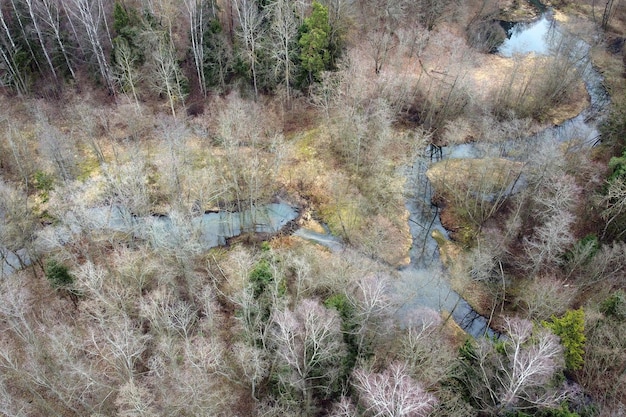
In conclusion, deforestation contributes to soil erosion and water quality degradation, affecting both terrestrial and aquatic ecosystems. Sustainable forest management practices are necessary to protect soil and water resources.
Climate Change and Deforestation
Climate change is another significant consequence of deforestation in the US. Forests play a crucial role in regulating the Earth’s climate by absorbing carbon dioxide, a major greenhouse gas, from the atmosphere. Deforestation releases this stored carbon back into the atmosphere, contributing to global warming.
The Carbon Sequestration Function of Forests
Trees absorb carbon dioxide during photosynthesis, the process by which they convert sunlight into energy. This carbon is stored in their wood, leaves, and roots. Forests act as significant carbon sinks, helping to reduce the amount of carbon dioxide in the atmosphere and mitigate climate change.
The Release of Carbon Dioxide
When forests are cleared, much of this stored carbon is released back into the atmosphere, either through burning or decomposition of the wood. This release of carbon dioxide contributes to the greenhouse effect, trapping heat in the atmosphere and causing global warming.
Deforestation also reduces the Earth’s capacity to absorb future carbon emissions. With fewer trees, there is less photosynthesis, and more carbon dioxide remains in the atmosphere.
Altered Local Climate Patterns
Deforestation can also alter local climate patterns. Forests provide shade and transpiration, which help to cool the air and regulate rainfall. When forests are removed, temperatures can increase, and rainfall patterns can become more erratic.
In summary, deforestation accelerates climate change by releasing stored carbon dioxide and reducing the Earth’s capacity to absorb future emissions. Protecting and restoring forests is vital for mitigating climate change.
Economic Impacts of Deforestation
Deforestation also has significant economic impacts in the United States. While some may see deforestation as a means to economic gain through logging and agriculture, the long-term consequences can be detrimental to various sectors of the economy.
Loss of Timber Resources
Unsustainable deforestation practices can lead to the depletion of timber resources. This can affect the timber industry, which relies on a steady supply of wood for construction, furniture, and paper production. Over time, deforestation can reduce the availability of timber, leading to higher prices and job losses in the industry.
Impacts on Tourism and Recreation
Forests provide recreational opportunities such as hiking, camping, fishing, and hunting. Deforestation can degrade these recreational areas, reducing their appeal to tourists and outdoor enthusiasts. This can negatively impact the tourism industry, which generates revenue for local communities.
Reduced Property Values
Deforestation can also reduce property values in surrounding areas. People often value living near forests for their aesthetic beauty, recreational opportunities, and ecological benefits. When forests are cleared, property values can decline, affecting homeowners and local tax revenues.
Deforestation can lead to increased costs for water treatment. When forests are cleared, soil erosion can increase, leading to higher sediment levels in rivers and streams. This can require more intensive and costly water treatment to ensure safe drinking water.
In conclusion, deforestation can have significant economic impacts, affecting the timber industry, tourism, property values, and water treatment costs. Sustainable forest management practices are essential for protecting economic interests and ecosystem health.
Conservation Efforts and Sustainable Forest Management
Addressing the potential impacts of deforestation on US ecosystems and biodiversity requires effective conservation efforts and sustainable forest management practices. These approaches aim to protect existing forests, restore degraded ecosystems, and ensure that forests are managed in a way that meets the needs of both people and the environment.
Protecting Existing Forests
One of the most important conservation strategies is to protect existing forests from deforestation. This can be achieved through the establishment of protected areas, such as national parks, wilderness areas, and conservation easements. These areas restrict or prohibit logging and development, ensuring that forests remain intact.
Restoring Degraded Ecosystems
Restoration efforts can help to rehabilitate degraded forests and restore their ecological functions. This can involve planting trees, removing invasive species, and improving soil health. Restoration projects can help to increase biodiversity, improve water quality, and enhance carbon sequestration.
Promoting Sustainable Forest Management
Sustainable forest management involves managing forests in a way that meets the needs of the present without compromising the ability of future generations to meet their own needs. Sustainable forestry practices include selective logging, reduced-impact harvesting, and reforestation. These practices aim to minimize the environmental impacts of logging and ensure that forests remain productive and healthy over the long term.
- Implementing stricter regulations on logging
- Offering incentives for private landowners to protect forests
- Educating the public about the importance of forest conservation
In conclusion, conservation efforts and sustainable forest management practices are essential for mitigating the impacts of deforestation and protecting the health and biodiversity of US forests. These approaches require collaboration among government agencies, private landowners, and other stakeholders.
| Key Aspect | Brief Description |
|---|---|
| 🏠 Habitat Loss | Destruction of natural environments leads to displacement of wildlife, reducing biodiversity. |
| 🌍 Climate Change | Deforestation contributes to global warming by releasing stored carbon dioxide into the atmosphere. |
| 💧 Water Quality | Soil erosion from deforestation pollutes rivers and streams with sediment, affecting aquatic life. |
| 📉 Economic Impacts | Deforestation can reduce timber resources, impact tourism, and lower property values in affected areas. |
Frequently Asked Questions
▼
Deforestation is the clearing of forests for other land uses, such as agriculture, urbanization, or logging. It involves removing trees without sufficient reforestation.
▼
Forests absorb carbon dioxide and produce oxygen. Deforestation reduces this capacity, leading to higher CO2 levels, which contribute to air pollution and climate change.
▼
Sustainable forest management, stricter regulations, reforestation efforts, and reducing consumption of products that drive deforestation are all important steps.
▼
Yes, the US has laws like the National Forest Management Act that regulate logging practices and protect certain forest areas from deforestation.
▼
Deforestation can disrupt local communities by reducing access to forest resources, decreasing property values, and affecting traditional ways of life tied to the forest.
Conclusion
What are the potential impacts of deforestation on US ecosystems and biodiversity? Deforestation poses significant threats to US ecosystems and biodiversity, leading to habitat loss, reduced species richness, soil erosion, water quality degradation, and climate change. Addressing these impacts requires a concerted effort involving conservation, sustainable forest management, and community engagement to protect these valuable natural resources for future generations.
